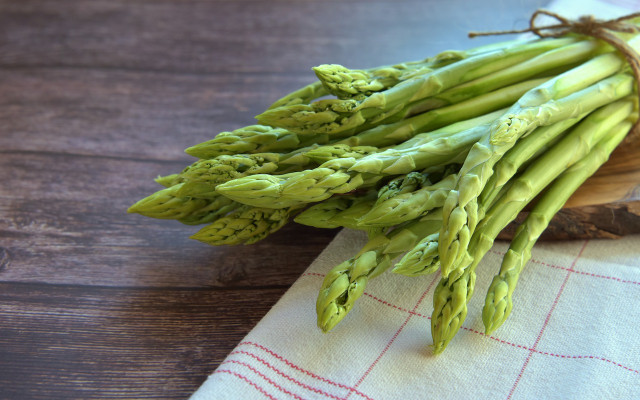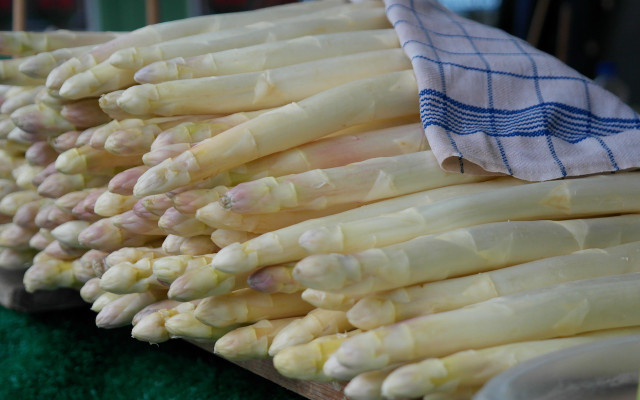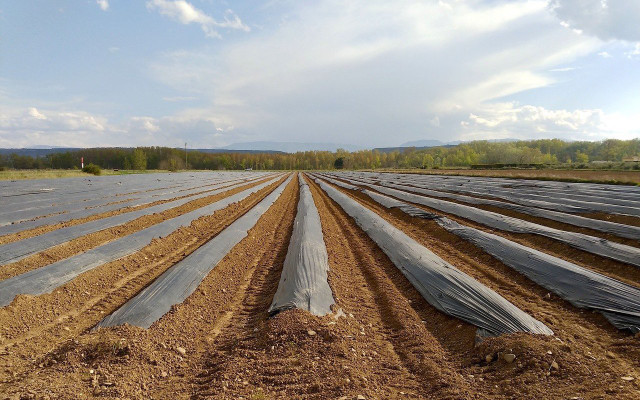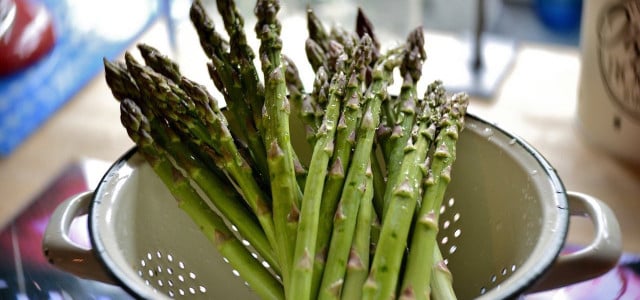Cooking asparagus can seem like a challenge, but it doesn’t have to be. In this article, we show you how to boil different kinds of asparagus so that the precious spring vegetable turns out just right.
Asparagus requires a gentle touch – just “cooking” it won’t get you very far. We’ll tell you exactly what you need to know when buying, peeling, or boiling green asparagus, the variety most common in the US, and white asparagus, the kind that is more familiar in Europe.
Green Asparagus: Instructions for Boiling and Frying

Green asparagus is easy to prepare because you usually don’t have to peel it. If the spears have a white-purplish color at the bottom, peel only that part. Otherwise, just cut off the tough “woody” ends and you’re good to go!
Ingredients for 2
- asparagus
- 2 tsp. salt
- 1 tsp. butter or vegan margarine
- a pinch of sugar
- white pepper
- 1 organic lemon slice (optional)
Cooking green asparagus
- Bring water to boil. Add salt, sugar and lemon slice. Add the asparagus and let it simmer on low heat.
- Green asparagus only takes 6-8 minutes to cook. Skinny spears only take about 4-5 minutes.
- Don’t let the asparagus simmer in the water for too long, otherwise the tips will get soggy.
Tip: Use a fork to lift an asparagus spear out of the water; the more it bends, the softer it already is. Depending on how soft you want it, you can take it out of the water sooner or later. Another way to test whether the asparagus is done, is to gently pierce the bottoms of the spears with a knife. It should be tender with a little crunch.
Frying green asparagus
- Grease a frying pan with oil or butter.
- Fry the spears (in one piece or cut up into smaller pieces) over high heat for about 5 minutes.
- Turn them regularly using a spatula.
- Add salt and white pepper.
Shallow boiling asparagus
Asparagus also turns out well if you shallow boil it in a large skillet with a lid. Shallow boiling is best described as a process that is somewhere between steaming and boiling the vegetables. The asparagus will be done in no time, and it will have a delicious taste.
- Fill the pan with about an inch of water. Add a slice of lemon and a large pinch of salt and bring water to a boil.
- Next, add the asparagus and spread it out evenly. Cover with a lid and let everything steam for no longer than 6 minutes. Thinner stalks only take about 2 minutes, bigger ones need to cook for about 5-6 minutes.
- Briefly rinse the asparagus with cold water, then serve right away.
- For a more refined taste, add some olive oil, thyme and oregano.
How to Cook White Asparagus



Now that you know how to boil green asparagus, let’s move on to another kind of asparagus. This recipe requires the same ingredients as before, except here you are buying white asparagus instead. However, the procedure of preparing and cooking white asparagus is quite different.
- First, peel the asparagus spears, sparing only the tips. Then cut off the tough ends.
- Insert the asparagus into a pot or pan of boiling water. It is important that they’re completely covered with water.
- Add salt, sugar, and butter or margarine. The sugar evens out the bitter taste of fresh white asparagus. Adding a slice of organic lemon will make it taste even more refreshing.
- Bring everything to a boil, then let it simmer on low heat. How long the asparagus needs to stay in the water depends on how thick the stalks are. Bigger spears take about 10-15 minutes, whereas thinner ones only need to simmer for 8-10 minutes.
You can test wether the asparagus is tender with a fork or knife, as described above.
Tip: your asparagus will turn out especially well if you cook it vertically, and there are special asparagus pots for this (available on Amazon**). Simply insert the asparagus spears so that they’re “standing” upright. The cooking process is the same as described above.
Buying Asparagus: What You Need to Know



First things first. Most locally-produced asparagus comes from the states of California, Washington and Michigan, where its season starts in February, April and May, respectively, and lasts until June. Always make sure you choose the grower that is closest to you. Though asparagus season is rather short, depending on the region, in the US, fresh asparagus is available almost year-round. Since most asparagus sold in the US is imported and freighted by air from Peru, it has an exceptionally large carbon footprint (National Geographic).
However, the local cultivation of asparagus also raises certain environmental concerns. Some farmers for instance use “thermal tunnels” or foils for early and speedy vegetable production. These tunnels are made out of plastic and cannot be easily recycled, so they are producing a large amount of waste. But do not despair, dear asparagus lovers. Just make sure you always buy asparagus when it is in season in your region and choose organic products to avoid food that has been treated with chemical-synthetic pesticides. You can even enjoy it out of season if you buy it fresh and then freeze it for later. Here’s an article on how that works: How to Freeze Asparagus: Preserving the Spring Vegetable
Important Information regarding Health-related Topics.
** Links to retailers marked with ** or underlined orange are partially partner links: If you buy here, you actively support Utopia.org, because we will receive a small part of the sales proceeds. More info.Do you like this post?






